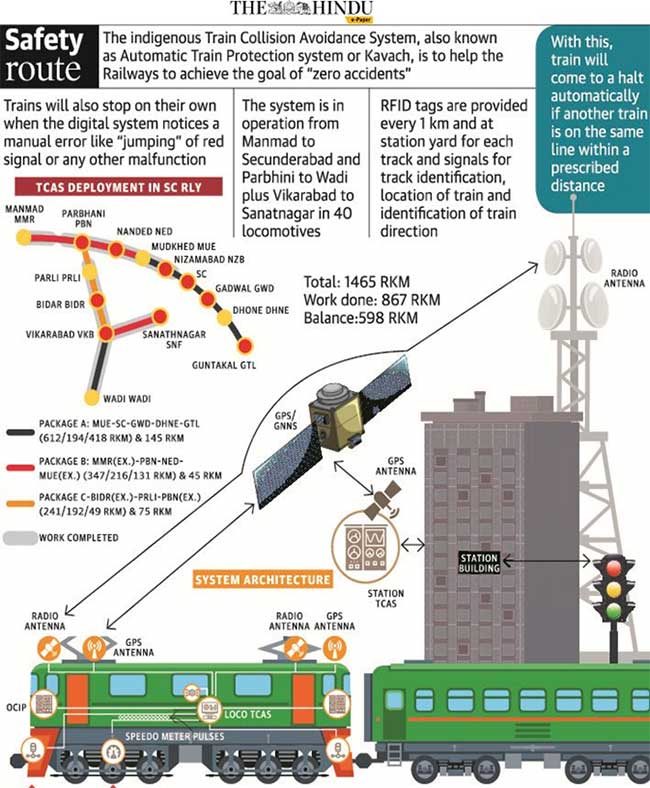Date : 05/06/2023
Relevance: GS Paper 3: Science and Technology
Key Words: Automatic Train Protection (ATP), Safety Integrity Level-4 (SIL-4),SoS messages, Radio Frequency Identification (RFID)
Context -
- The recent tragic train accident in Balasore district, Odisha, resulting in the loss of over 288 lives, has highlighted the urgent need for safety measures to prevent such incidents. Both the Shalimar-Chennai Coromandel Express and the Yeshwanthpur-Howrah Express were not fitted with KAVACH-TACS.
- One such safety mechanism is the Kavach system, an Automatic Train Protection (ATP) system developed by the Research Design and Standards Organisation (RDSO) in collaboration with the Indian industry.
- Kavach, this indigenously developed Automatic Train Protection System is earmarked for aggressive rollout on 2,000 km in 2022-23, according the Budget proposals.
Key Features of the Kavach System:
- Safety Integrity Level-4 (SIL-4) Standards: The Kavach system is a state-of-the-art electronic system designed with SIL-4 standards, ensuring a high level of safety and reliability.
- Prevention of Signal Violation and Collisions: The Kavach system prevents trains from passing a signal at Red, which indicates danger. It activates the train's braking system automatically if the driver fails to adhere to speed restrictions. Additionally, it prevents collisions between locomotives equipped with functional Kavach systems.
- SOS Messages and Network Monitoring: In emergency situations, the Kavach system relays SOS messages. Furthermore, it offers centralized live monitoring of train movements through the Network Monitor System.
- Cost-Effective and Reliable: The Kavach system is one of the most affordable SIL-4 certified technologies, with a probability of error of 1 in 10,000 years.
Functioning of the Kavach System on Railway Systems:
- The Kavach system utilizes the Traffic Collision Avoidance System (TCAS) to facilitate two-way communication between the station master and the loco-pilot.
- The system relies on equipment onboard the locomotive and transmission towers at stations, connected via Radio Frequency Identification (RFID) tags. The loco-pilot is provided with an instrument panel inside the cabin that displays signals in advance and the permissible speeds to be maintained.
- If a red signal is ignored and two trains approach each other on the same track, the Kavach system takes control and applies sudden brakes. Additionally, the system activates a hooter near level crossings, aiding loco-pilots during low visibility conditions like fog.
Implementation of the Kavach System:
- The South Central Railway (SCR) Zone has been at the forefront of implementing the Kavach system. As of March this year, the Kavach system has been deployed over 1,465 kilometers in the SCR limits, covering 77 locomotives and 135 stations.
- The SCR-based Indian Railways Institute of Signal Engineering & Telecommunications (IRISET) serves as the "Centre of Excellence" for Kavach. IRISET is responsible for training railway staff on Kavach through year-round programs.
Kavach Deployment Strategy:
- The Railway Board has adopted a focused approach to implement the Kavach system. The first priority is given to High-Density Routes and the New Delhi-Mumbai and New Delhi-Howrah Sections, where the probability of accidents is higher due to trains running closely.
- The second priority includes Highly Used Networks, followed by other Passenger High-Density Routes, and finally, covering all other routes.
- The RDSO has approved three firms, namely Medha Servo Drives, HBL, and Kernex, for providing Kavach equipment, with two more firms being considered. The Kavach system has addressed various challenges such as closed level crossings, stray cattle or obstructions on tracks, and radio communication issues in tunnels and ghat sections.
Conclusion:
While challenges such as closed level crossings, obstructions, and communication issues have been addressed, the Kavach system continues to evolve and adapt to emerging vulnerabilities .Looking ahead, the widespread implementation of the Kavach system holds immense promise for the future of Indian Railways. By expanding its coverage to other networks and routes, the Kavach system can serve as a cornerstone in achieving comprehensive safety standards and minimizing accidents.
Probable Questions for Mains exam-
- Question 1: Discuss the salient features and significance of the Kavach system, an indigenously developed Automatic Train Protection (ATP) system, in ensuring the safety of train operations in India. (10 marks,150 Words)
- Question 2: Critically analyze the statement made by Jaya Varma Sinha, a member of the Operation and Business Development, Railway Board, regarding the limitations of technology in preventing accidents. Provide your perspective on the role of advanced systems like Kavach in minimizing accidents and ensuring passenger safety. (15 marks, 250 Words)
Source: The Hindu









